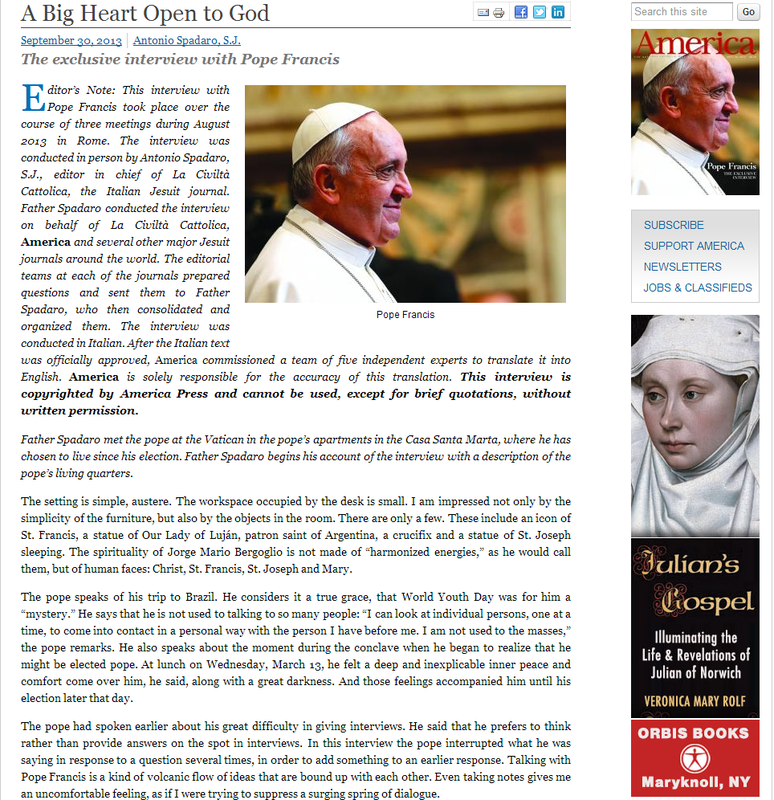|
In the Tenth Revelation, Julian of Norwich saw Jesus looking down from the cross toward his right side. Then, with an expression of pure joy, he led Julian through the gaping wound into his Sacred Heart. And there he showed a fair, delectable place, and large enough for all mankind that shall be saved to rest in peace and in love. For we are his bliss, for in us he delights without end, and so shall we in him with his grace. All that he has done for us, and does, and ever shall, was never cost nor charge to him nor might be, but only that he did it in our humanity, beginning at the sweet incarnation, and lasting to the blessed resurrection on Easter morrow.
Lest we become too literal about such an intimate and graphic image, it is important to distinguish between Christ’s physical heart that was pierced by a spear and poured out blood and water, and his divine heart, the symbol of Christ’s “endless love that was without beginning, and is, and shall be forever.” Julian was invited to enter into that love, and so are we. And with this, our good lord said full blissfully: “Lo, how I loved thee” as if he had said: “My darling, behold and see thy lord, thy God, that is thy maker and thy endless joy. See thine own brother, thy savior. My child, behold and see what delight and bliss I have in thy salvation, and for my love enjoy it with me.” In the Eleventh Revelation, Jesus looked further down on the right side, which brought to Julian’s mind where his mother stood at the foot of the cross (as in many medieval frescoes, paintings, and carved wooden depictions of the crucifixion). Christ asked Julian if she would like to see how much he loves his blessed mother, as if to say: “Wilt thou see how much I love her, that thou might rejoice with me in the love that I have in her and she in me?” To Julian, it seemed that Christ was asking “Wilt thou see in her how much thou art loved?” Julian eagerly “expected to have seen her in bodily likeness,” just as she saw Christ on the cross, “But I saw her not so.” Instead, Christ showed Julian an imaginative vision of Saint Mary, rejoicing in heaven with her Son. In this tender revelation of Christ’s boundless love for his mother, Julian understood how much he loves every single person. In fact, it is for love of us that Christ has made Saint Mary “so exalted, so noble, so worthy”; that we might take joy in her and that she might be our inspiration. Then in the Twelfth Revelation, Julian was privileged to see our Lord “more glorified as to my sight than I saw him before.” She was taught that the soul shall never have rest until it comes into God, since God alone is the fullness of all joy: “homely and courteous and blissful and full of true life.” Oftentimes our lord Jesus said: “I it am, I it am. I it am that is highest. I it am that thou lovest. I it am that thou likest. I it am that thou servest. I it am that thou longest for. I it am that thou desirest. I it am that thou meanest. I it am that is all. I it am that holy church preacheth to thee and teacheth thee. I it am that shewed myself before to thee.” This magnificent litany assured Julian that Christ is the only one who can satisfy her longing to praise, to love, to like, to serve, to long for, to desire, to give meaning to her whole life, and to be her “all.” He is also the one holy church preaches and teaches. And the Lord affirms that it is he, and he alone, who has revealed himself to her. The number of the words [Christ spoke] passes my wits and my understanding and all my powers, for they were in the highest number, as to my sight. For therein is comprehended I cannot tell what. But the joy that I saw in the showing of them surpasses all that heart can think or soul may desire. And therefore these words are not declared here. It should be noted that in Middle English, the verb “like” (above) expressed even more intimacy than “love.” Julian understood that Christ wants us to “like” what he is accomplishing in us and for us. Julian was hopeful that everyone, according to God’s grace, will receive these words in whatever way the Lord has spoken them to each one of us, personally. What do they mean for you? May Julian guide you to take these three Revelations into meditation during the feast days of the Sacred Heart of Jesus and the Immaculate Heart of Mary. And may you be blessed abundantly! PLEASE NOTE: Translations from the Middle English and excerpts above are from my book, An Explorer’s Guide to Julian of Norwich (InterVarsity Academic Press), © Copyright by Veronica Mary Rolf. Available from the Publisher and Amazon worldwide: https://www.amazon.com/gp/product/0830850880?
0 Comments
|
Archives
June 2024
-amazon.com/author/veronicamaryrolf
All text copyrighted © 2013-2018 by Veronica Mary Rolf. All rights reserved. No copying or reprints allowed without the express permission of the Author. |
 RSS Feed
RSS Feed
